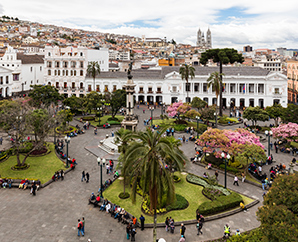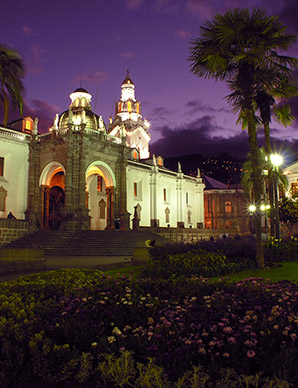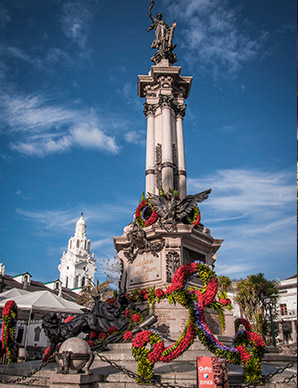If you think it’s just a place for tourists, try going on a Sunday afternoon. Quito’s Plaza Grande, the most important reference point in the city’s bustling historic center, will be packed with local families, preachers, accordion players, and shoe shiners. The landmark has gone through a lot of changes in the more than 400 years that have passed since the city’s founding, but it’s still one of the most important and iconic places in Quito.
The center of political life in the capital
Looking at each of the buildings that surround the Plaza Grande can help to give you an idea of the space’s original intention: a display of power in the colonial era. Each of the four sides represents a different colonial or governmental authority.
 Carondolet Palace sits on the west side of the plaza. It was originally built to serve as the seat of government and the home of the President of the Real Audencia of Quito, and is now the official residence of the President of the Ecuadorian Republic. If you get a chance to go in, keep an eye out for Ecuadorian painter Oswaldo Guayasamin’s masterful mural depicting the descent of conquistador Francisco de Orellana down into the Amazon Basin. The Palace is open to visitors from 9 am to 12 pm and from 3 pm to 5 pm.
Carondolet Palace sits on the west side of the plaza. It was originally built to serve as the seat of government and the home of the President of the Real Audencia of Quito, and is now the official residence of the President of the Ecuadorian Republic. If you get a chance to go in, keep an eye out for Ecuadorian painter Oswaldo Guayasamin’s masterful mural depicting the descent of conquistador Francisco de Orellana down into the Amazon Basin. The Palace is open to visitors from 9 am to 12 pm and from 3 pm to 5 pm.
On the southern side stands the National Cathedral, representing the power of the Catholic church, an even more influential political institution at the time of Quito’s founding than it is now. Very rarely, special events allow visitors to climb up to the top of the roof and look out on Quito’s historic center from between the cathedral’s impressive domes.

The stalls beneath the atrium of the cathedral have now been converted into a handful of cozy cafés and restaurants, where you can enjoy Ecuadorian classics like sánduche de pernil, seco de chivo, and locro de papa, or just have a coffee and watch all the people go by.
The municipal building that sits on the eastern side of the square was built in the 1970s, replacing the dilapidated 19th century building that had served as the municipal head and mayor’s residence before then. It now houses a variety of government offices. On the side of the building closest to calle Espejo, you can also find a souvenir shop and the offices of Trenes de Ecuador.
Building that mades up the northern edge of the plaza was is the Archbishop’s Palace. It used to be the home of the archbishop of Quito, the highest authority from the Catholic church in the region. The building has now been converted into a commercial space, a small shopping center with stores and restaurants.
Changes to the Plaza Grande over time

When Quito was first founded, the central square was just a dirt area with a fountain in the middle, which would have served as a water source for nearby houses in the time before indoor plumbing allowed people to pipe water into their houses.
During the early years of the Ecuadorian republic, the Plaza Grande went through significant changes under the rule of President Gabriel García Moreno. He wanted to modernize Quito by bringing in French influences, so the quaint colonial square was turned into a Parisian-style park surrounded by an iron gate. (García Moreno’s other major legacy to be found in the Plaza Grande is the plaque commemorating the site of his assassination, at the base of Carondolet Palace!)
In the twentieth century, the plaza underwent even more dramatic changes thanks to increased automobile traffic in the surrounding streets. And it was in 1909 that the Monumento a la Independencia was built in the center of the plaza to honor those who fought in Ecuador’s Independence struggle.
So if you thought that the Plaza Grande was just a tourist site, think again. It’s still an alive and where many protests and social movements come to demonstrate about their political causes. They say that no revolution will be successful if it doesn’t reach the Plaza Grande, and no visit to Quito is complete without spending some time here to learn about the history of this iconic landmark!
